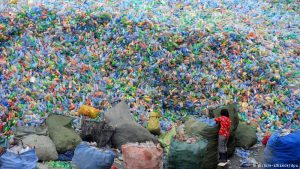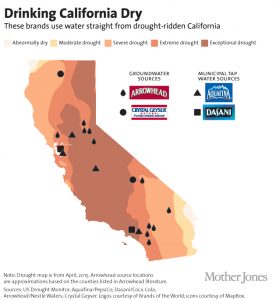In May 2017, Augsburg approved a new Policy on Bottled Water that aims to reduce waste and greenhouse gas emissions and support the provision of water as a human right and not a commodity. To support policy implementation as we #LoveLocalWater, Fall 2017 Environmental Connections (ENV 100) students created projects to address knowledge gaps, resource needs, and communications opportunities. Check back each week in January as we feature a blog series on different aspects of bottled water written by one of those project groups!
By Holly Kundel, ‘19
At a glance, bottled water seems convenient and harmless. However, when looking at the issue of bottled water from an environmental standpoint, it becomes quite complex. That is because you must consider where the plastic comes from to make the bottles, what happens to the plastic bottles after the water inside has been consumed, and where does the water actually come from? I will be focusing mostly on the impacts of the plastic and the water itself.
Personally, the first problem with bottled water that comes to my mind is the plastic bottles that they are sold in. Although most if not all plastic bottles are made of a plastic called PET (polyethylene terephthalate), which is recyclable, most Americans don’t recycle them. In an NPR Podcast “War on Tap: America’s Obsession with Bottled Water” Peter Gleick stated “In the United States, probably 70 or 75 percent of the plastic water bottles that we buy and consume are never recycled. The industry likes to tell us that PET plastic is completely recyclable. And that’s true, but there’s a big difference between recyclable and recycled, and the truth is we’re bad at recycling. We don’t recycle most of the materials that we use that could be recycled. And the stuff that isn’t recycled, it goes to landfills. And when it goes to landfills, it’s buried, and it lasts forever, effectively forever.”

This statistic is shocking, but you may be saying, “Well I recycle all of mine, so what’s the problem?” Peter Gleick went on to explain that instead of taking recycled plastic bottles to make new bottles, America’s recycled plastic usually gets sent to China. Here it is used to make fabric, rugs and clothing. So this plastic is getting “down-cycled” instead of recycled. This means that in order to make more bottles, they need more crude oil, the source of raw material to create plastic. Oil extraction releases greenhouse gases that are a leading causing of climate change, and plastics production releases additional toxics into the environment. In addition to those harms, bottled water usually isn’t a local enterprise. According to the article “Life Cycle of a Plastic Water Bottle” in some cases of transporting bottled water, it can take more than a liter of gasoline per bottle. According to the article “How Much Energy Goes into Making a Bottle of Water” producing and transporting bottled water uses up to 2,000 times the energy required to produce and distribute tap water. It is also estimated that approximately one in four bottles of water crosses at least one international border in route to its final destination.

In addition to the plastic from the bottles themselves being harmful to the environment, the water itself can cause harm. Bottled water, which you might recall isn’t all that special (see our previous post about the health and safety of bottled water), is taking water from places that are running dry. For example, there are a variety of companies that bottle water in California, a state that is terrorized by drought. Although many companies bottle water from municipal sources, some actually do bottle spring water. But the springs often can’t support the amount of water being taken from them, and at times, even dry up. An article called “‘Not one Drop’ of Polish Spring bottled water is from a Spring, Lawsuit claims” quotes “the famous Poland Spring in Poland Spring, Maine, which defendant’s labels claim is a source of Poland Spring Water, ran dry nearly 50 years ago.” Even though bottled water companies are distributing drinking water, it can drain sources that local communities rely on.

After learning about all of the ways that plastic water bottles negatively impact the environment, I’ve decided to stop buying them all together. It is important to understand that there are some communities, and certain circumstances where bottled water is necessary. Examples include areas impacted by natural disasters or towns where their tap water is unsafe. But here in the city of Minneapolis, where we are blessed with great tap water, it just isn’t logical to go with plastic bottles. It’s also much more economical to purchase one reusable water bottle, that you can fill an infinite number of times, than to continue to purchase plastic bottles. I believe that every individual has the ability to make a difference! Some of these environmental problems that we are facing seem too daunting to solve. But don’t let this fear stop you from doing what you can to help solve these problems! Everyone has the power to make a difference! By purchasing less plastic water bottles, we can limit the amount of plastic getting tossed into landfills and down-cycled. In addition to that, if less people are buying plastic water bottles, then less petroleum will need to be extracted from the ground to make new bottles. All of these benefits for our environment come from a choice you the consumer get to make. The facts are staggering, and bottled water in most circumstances doesn’t make sense the more you think about it. So the next time you want to quench your thirst, try water from your tap – the environment will thank you.
